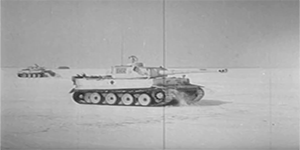SS-Panzergrenadier-Division Leibstandarte SS was to be the anvil of the counterattack based around Krasnograd, while Das Reich and the newly arrived Totenkopf Division swung south and then northwards, forcing the Soviets back onto the guns of the Leibstandarte SS. The Waffen-SS men raced forward at such a break-neck speed that Soviet and German troops often became intermingled. Taken completely by surprise by this unexpected German push, the Soviets retreated northwards in near panic. The Das Reich and the Totenkopf swung to the northeast and run parallel to the Soviet lines of retreat, hammering into the flunks of the fleeing enemy. What followed over the next few days was little more than a slaughter as the powerful Waffen-SS units wreaked havoc among the demoralized enemy. Two entire Soviet armies were destroyed, and over 615 enemy tanks were either knocked out or captured, most of them the latest T-34 models. Over 354 artillery pieces and 600 anti-tank guns were also captured during the first phase of the counterattack. Although they had to abandon their heavy equipment, many Soviet troops were able to make good their escape on foot. Around 9,000 were taken prisoner and 23,000 killed. Generalfeldmarschall Erich von Manstein's 350 tanks outnumbered Soviet armor almost seven to one at the point of contact. Once having rejoined SS-Obergruppenführer Paul Hausser's SS-Panzerkorps, after taking part in the destruction of the Kegitschevka pocket, Leibstandarte SS led the way back to the city of
Kharkov. Credit: British authors Gordon Williamson, Tim Ripley and George Nipe. Top image: SS-Standartenführer
Fritz Witt, Commander of SS-Panzer-Grenadier-Regiment 1
Leibstandarte SS during the Donets Campaign. Witt was an original member of the
SS-Stabswache Berlin. Commons: Bundesarchiv. Bottom clips: SS-Panzerkorps began its counterattack on February 19 1943. Panzerkampfwagen Tiger n°405 was commanded by Leibstandarte SS company commander SS-Hauptsturmführer
Heinrich Kling. Footage from Die Deutsche Wochenschau.



This comment has been removed by a blog administrator.
ReplyDelete